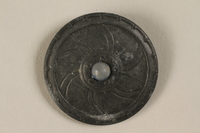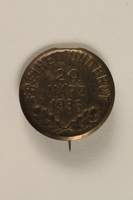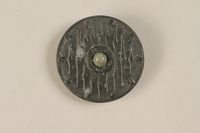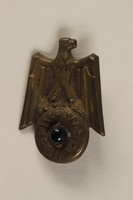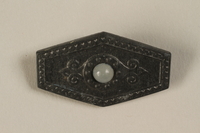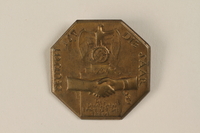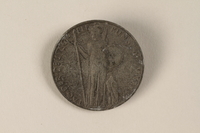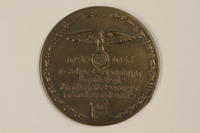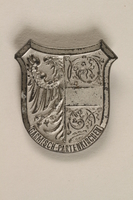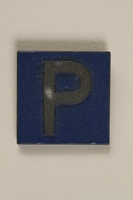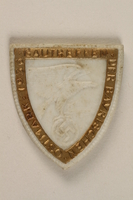Overview
- Brief Narrative
- Nazi Party Labor Day (Tag der Arbeit) 1934 pin. Labor Day (also known as May Day) takes place on May 1 to celebrate laborers and the working classes. In April 1933, after the Nazi party took control of the German government, May 1 was appropriated as the “Day of National Work,” with all celebrations organized by the government. On May 2, the Nazi party banned all independent trade-unions, bringing them under state control of the German Labor Front. This style of mass-produced, die stamped pin is often referred to colloquially as a tinnie.
- Date
-
issue:
1934
commemoration: 1934 May 01
- Geography
-
manufacture:
Ansbach (Germany : Landkreis)
- Credit Line
- United States Holocaust Memorial Museum Collection, Gift of Mark Esterman. These publications were obtained in Germany in 1935 by Benjamin and Sophie Esterman, American citizens who were traveling in Europe, and visited Germany in order to see for themselves and to inform others where Nazism was going. They are donated in the same spirit to the Holocaust Museum by the children of Benjamin and Sophie Esterman and their families; to bear witness and to warn of the cruelty and danger of bigotry, racial prejudice, and hatred.
- Markings
- front, top, embossed : TAG DER ARBEIT [LABOR DAY]
front, bottom center, embossed : 1934
back, center, stamped : RZM / 14 [Matth. Oeschsler & Sohn, Ansbach] - Contributor
-
Designer:
Richard Klein
Physical Details
- Language
- German
- Classification
-
Identifying Artifacts
- Category
-
Badges
- Object Type
-
Lapel pins (aat)
- Genre/Form
- Badges.
- Physical Description
- Circular, bronze-colored, metal pin with an embossed design. The top center has a head of a man flanked by a hammer on the left and a sickle on the right. Below the head is a Parteiadler, a stylized eagle with its head turned to the right, holding in its claws a wreath with a swastika in its center. German text is around the border above the hammer and the sickle, with numbers at the bottom split by the wreath. A safety-pin style clasp is soldered to the back. The pin may be made from a bronze alloy known as tombac, a mixture of copper and zinc.
- Dimensions
- overall: | Depth: 0.250 inches (0.635 cm) | Diameter: 1.375 inches (3.493 cm)
- Materials
- overall : metal
Rights & Restrictions
- Conditions on Access
- No restrictions on access
- Conditions on Use
- No restrictions on use
Keywords & Subjects
- Geographic Name
- Germany
- Corporate Name
- Nazi Party
Administrative Notes
- Legal Status
- Permanent Collection
- Provenance
- The lapel pin was donated to the United States Holocaust Memorial Museum in 1996 by Mark Esterman.
- Record last modified:
- 2023-11-17 10:04:09
- This page:
- https://collections.ushmm.org/search/catalog/irn11766
Download & Licensing
In-Person Research
- By Appointment
- Request 21 Days in Advance of Visit
- Plan a Research Visit
- Request to See This Object
Contact Us
Also in Mark Esterman collection
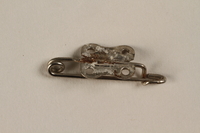
Safety pin from a Nazi badge
Object
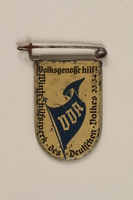
Nazi "Winter Relief" badge
Object
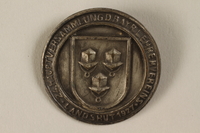
Bavarian Teachers' Union pin
Object
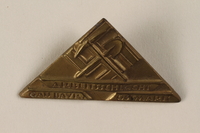
Nazi labor service badge
Object
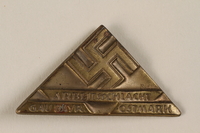
Nazi labor service badge
Object
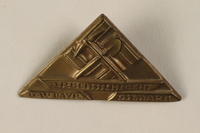
Nazi labor service badge
Object
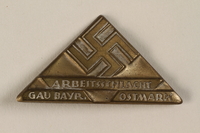
Nazi labor service badge
Object
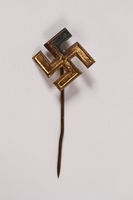
Swastika stick pin
Object
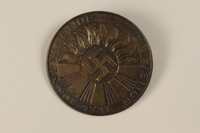
Nazi Party election badge.
Object
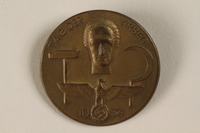
Nazi Party pin for Labor Day 1934
Object
Nazi Party Labor Day (Tag der Arbeit) 1934 pin. Labor Day (also known as May Day) takes place on May 1 to celebrate laborers and the working classes. In April 1933, after the Nazi party took control of the German government, May 1 was appropriated as the “Day of National Work,” with all celebrations organized by the government. On May 2, the Nazi party banned all independent trade-unions, bringing them under state control of the German Labor Front. This style of mass-produced, die stamped pin is often referred to colloquially as a tinnie.
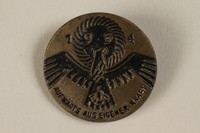
Nazi Party badge
Object

Nazi Party badge
Object
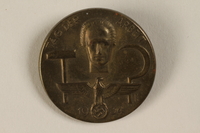
Nazi Party pin for Labor Day 1934
Object
Nazi Party Labor Day (Tag der Arbeit) 1934 pin. Labor Day (also known as May Day) takes place on May 1 to celebrate laborers and the working classes. In April 1933, after the Nazi party took control of the German government, May 1 was appropriated as the “Day of National Work,” with all celebrations organized by the government. On May 2, the Nazi party banned all independent trade-unions, bringing them under state control of the German Labor Front. This style of mass-produced, die stamped pin is often referred to colloquially as a tinnie.
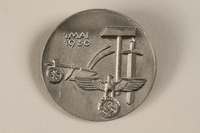
Nazi Party pin for Labor Day 1936
Object
Nazi Party Labor Day (Tag der Arbeit) 1936 pin. Labor Day (also known as May Day) takes place on May 1 to celebrate laborers and the working classes. In April 1933, after the Nazi party took control of the German government, May 1 was appropriated as the “Day of National Work,” with all celebrations organized by the government. On May 2, the Nazi party banned all independent trade-unions, bringing them under state control of the German Labor Front. This style of mass-produced, die-struck metal pin is often referred to colloquially as a tinnie.
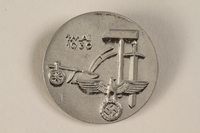
Nazi Party pin for Labor Day 1936
Object
Nazi Party Labor Day (Tag der Arbeit) 1936 pin. Labor Day (also known as May Day) takes place on May 1 to celebrate laborers and the working classes. In April 1933, after the Nazi party took control of the German government, May 1 was appropriated as the “Day of National Work,” with all celebrations organized by the government. On May 2, the Nazi party banned all independent trade-unions, bringing them under state control of the German Labor Front. This style of mass-produced, die-struck metal pin is often referred to colloquially as a tinnie.
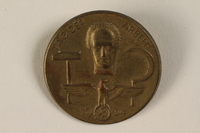
Nazi Party pin for Labor Day 1934
Object
Nazi Party Labor Day (Tag der Arbeit) 1934 pin. Labor Day (also known as May Day) takes place on May 1 to celebrate laborers and the working classes. In April 1933, after the Nazi party took control of the German government, May 1 was appropriated as the “Day of National Work,” with all celebrations organized by the government. On May 2, the Nazi party banned all independent trade-unions, bringing them under state control of the German Labor Front. This style of mass-produced, die stamped pin is often referred to colloquially as a tinnie.

Nazi Party pin for Labor Day 1934
Object
Nazi Party Labor Day (Tag der Arbeit) 1934 pin. Labor Day (also known as May Day) takes place on May 1 to celebrate laborers and the working classes. In April 1933, after the Nazi party took control of the German government, May 1 was appropriated as the “Day of National Work,” with all celebrations organized by the government. On May 2, the Nazi party banned all independent trade-unions, bringing them under state control of the German Labor Front. This style of mass-produced, die stamped pin is often referred to colloquially as a tinnie.
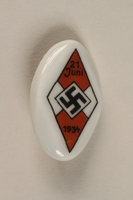
Hitler youth badge
Object
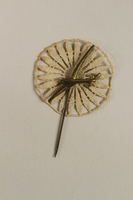
Nazi aviation stickpin
Object
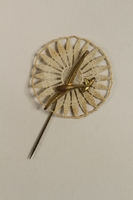
Nazi aviation stickpin
Object
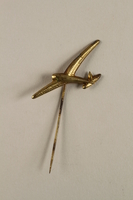
Nazi aviation stickpin
Object
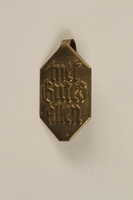
Nazi Party badge
Object
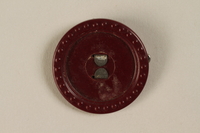
Nazi Party badge
Object
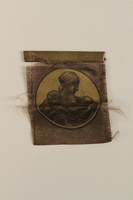
Nazi Mothers' Day badge
Object
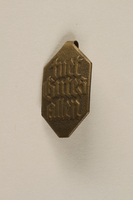
Nazi Party badge
Object

Red Cross badge
Object
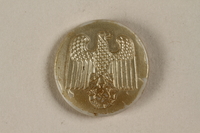
Nazi Party badge
Object
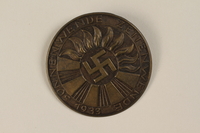
Nazi Party election badge
Object
Booklet
Object
Booklet
Object
Safety pin from a Nazi badge
Object


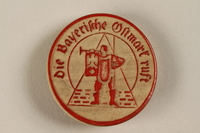
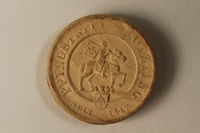
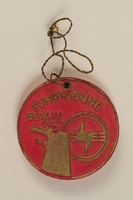
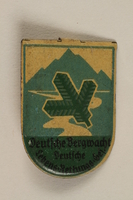
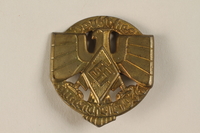
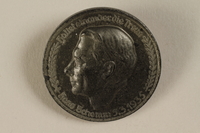
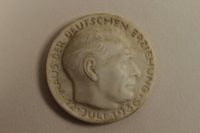
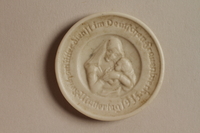
![Hitler Youth [Hitler Jugend/Bund Deutscher Mädel] badge Hitler Youth [Hitler Jugend/Bund Deutscher Mädel] badge](https://www.ushmm.org/media/emu/get?irn=11744&mm_irn=18191&file=secondary)
